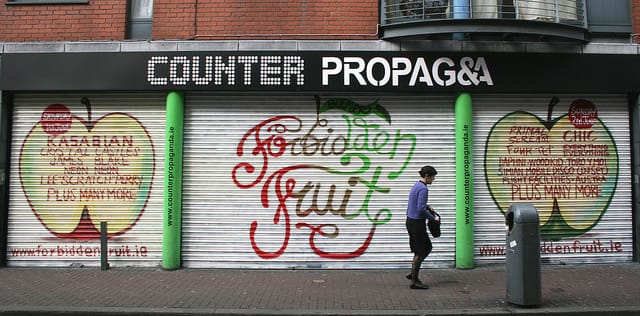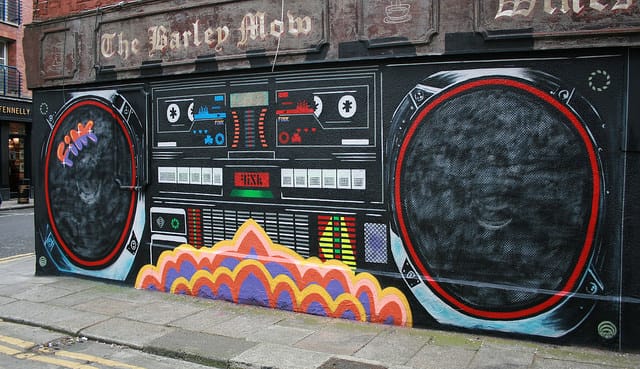What’s the best way to tell area residents about plans for a new asylum shelter nearby?
The government should tell communities directly about plans for new asylum shelters, some activists and politicians say.
You might not know it, but you’ve probably seen street artist Fink’s murals somewhere in town. Catch him in action on Culture Night on Francis Street.

I’m supposed to meet Fink, one of Dublin’s most popular street artists, in Ranelagh, where he’s supposed to be transforming a traffic signal box into a work of art.
Problem is, it’s lashing rain. So, we meet for a coffee on Harcourt Street instead.
His work, as you can imagine, is weather dependent.
“You can’t paint in the rain,” he says. “Well, you can, but it’s a nightmare. Very messy.”
If you haven’t heard of Fink, the chances are you’ve probably seen his work. He’s done murals on walls around the city and commercial work for places such as the Little Ass Burrito Bar on Dawson Street and for festivals including Forbidden Fruit.
But his most famous piece, which garnered huge media

attention both here and abroad, was his mural inspired by the marriage referendum.
One multicoloured love heart equaling another multicoloured love heart on a black background.
It was picked up by the Irish Times, the Telegraph, the Guardian, the Hans India and the Los Angeles Times to name a few.
“It went everywhere,” he says, still surprised. “And the feedback, Jesus; People were hugging me on the street.”
“And it was so simple,” he says. “It took less than a day, but it was effective. You could spend five days on something and you mightn’t be as happy or it doesn’t turn out as well.”
In his forties now, Fink has been a street artist for 15 years. He says he couldn’t do anything else.
His best result in the Leaving Cert was an “A” in art, which allowed him to go on to college in England, where he studied Visual Communication.

But even as a kid, he was big into street art, starting off with graffiti.
“I did a graffiti piece when I was 14. I went back the next day to take a photo and they’d sand-blasted the whole wall. Obviously it was illegal,” he says.
It’s a problem starting out, Fink says, doing it without getting caught.
He’s had a few brushes with the law. “A few visits to the cop shop, but nothing too severe, but I can’t really afford to get caught again.”
Fortunately, Fink is quite established now and he gets a lot of commission work which is legal. Also, he has an agreement with the owner of a derelict building on the corner of Francis Street and Mark’s Alley West, the site of the now defunct Barley Mow pub, so he paints a lot of his murals there.

Also, he says, Gardai are more friendly to street art as opposed to graffiti.
“Graffiti, unfortunately, is still seen as wrecking the place,” he says. “Although, more people are opening their minds to it.”
A major reason for the recent surge in the popularity of street art is Banksy.
“I’ve been into Banksy since day one,” Fink says, “but there was plenty of artists doing street art and cutting stencils, but he’s the one who broke the mould, I suppose, and put street art on the map.”
“I love his work, but there are other artists I probably prefer. But you have to hand it to him for what he’s done.”
Much of Banksy’s work, and street art in general, is social commentary. Some of Fink’s work is too, such as the referendum mural. But some of it is also inspired by his other influences: sci-fi, especially Star Wars, comic books and music.
He’s a product of acid house circa 1989, he says. “That’s totally shaped my artist ventures, the influences of acid house.”
He’ll be painting a mural this Friday for Culture Night, at his usual location at the corner of Francis Street and Mark’s Alley West. He’s a fair idea of what he’ll be doing, but is undecided about a couple of things.
But he’s not concerned; he’ll have it sorted. His plan is to finish the traffic signal box and then start work on the mural on Wednesday to have a good deal of it done by Culture Night.

For a man with two deadlines this week, he’s remarkably calm.
He says he’s never had any form of creative block. A few months ago, he injured his leg playing football. He couldn’t bend it for six weeks, so he couldn’t work.
“But it wasn’t a block; it was just a nice break,” he says. “It did me good I think. As soon as I could walk again I got a load of job offers.”
He says he’s making a decent living out of street art. He gets a lot of commission work, both commercial and private.
“A lot of private stuff,” he says. “People’s back gardens and in their houses.”

The Dublin Bar Academy has commissioned him to paint a mural when they move to their new premises, a big warehouse.
“It’s a massive job and it’s supposed to be happening next month,” he says. “It’s colossal.”
He’ll probably have to call in a friend to help. “Which,” he says, “is grand. Adds a bit a spice with two artists.”
“I’m looking forward to that,” he says. “The bigger the better.”
When the interview finishes, I’m in a hurry to get to my next one.
Fink, on the other hand, despite having two looming deadlines, one of which, the one for Culture Night, is a forty-foot mural that he’s not even 100 percent sure on just yet, is in no rush at all.
We shake hands; he hangs back to get himself another coffee.
It’ll all come together.
You can catch Fink painting a mural all day this Friday as part of Culture Night outside the old Barley Mow pub at the corner of Francis Street and Mark’s Alley West, Dublin 8.
Get our latest headlines in one of them, and recommendations for things to do in Dublin in the other.